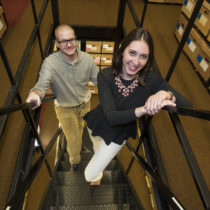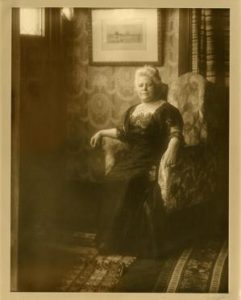Magazine

Hidden Collections
By Lilly Carrel and Devon Proudfoot
Archives seek to collect and preserve the stories of all people, but many stories remain untold. To help change that, we are part of a team of archivists who are diving into Bentley records to uncover and highlight the role of women at the University during its first 100 years.
Our role in this new Bentley project, launched in 2016, aims to increase access to material by or about women, by enhancing the tools that enable users to discover them, such as library catalog records and finding aids, which are online guides or indexes explaining what’s in each collection.
In many cases, women’s records are underrepresented in collections documenting University history before 1917,, including the papers of University of Michigan presidents. While the work of visionaries such as U-M’s fourth president, Harry B. Hutchins (1909-1920), is significant to U-M’s story, no less important is the work of his wife, Mary Louise Crocker.

Mary Crocker Hutchins. BL021474.
To discover Mary’s story, we first consulted the Harry B. Hutchins papers finding aid. We were looking for any references to Mary, a wife, or general biographical information. We found a note mentioning the presence of Mary’s obituary, but when we uncovered it in the archive, the obituary turned out to be mostly an account of Mary’s male lineage, with cursory mention of the events and accomplishments in Mary’s own life.
This characterizes one of the primary obstacles of the Hidden Collections project: During the 19th and 20th centuries, women did not create records in equal volume to men, and, what records women did create, were not considered of scholarly value. Often these records weren’t preserved or, when they were saved, they weren’t adequately described, inhibiting researchers’ awareness and access. In other words, women’s activities, records, and, by extension, women’s stories were not viewed as important.
In Mary’s case, our continued examination of the finding aid revealed the presence of photographs and more pertinent biographical material in Harry’s biography. With this additional information, we updated the Biographical Note in the finding aid to include a paragraph about Mary’s life before she married Harry and how she contributed to the success of his U-M presidency; we marked the photographs for digitization and inclusion in the online Bentley Image Bank; and we added a subject heading, based on the Library of Congress’ name authority standard that included Mary’s maiden name and her birth and death dates. Making note of Mary in the finding aid, previously focused solely on the achievements of her husband, enhances our understanding of Harry’s life and gives Mary a long-overdue presence in the historical record.
This project is one effort, among so many, that seeks to fulfill the Bentley’s mission and embrace the future by enabling access to the stories of our past.
